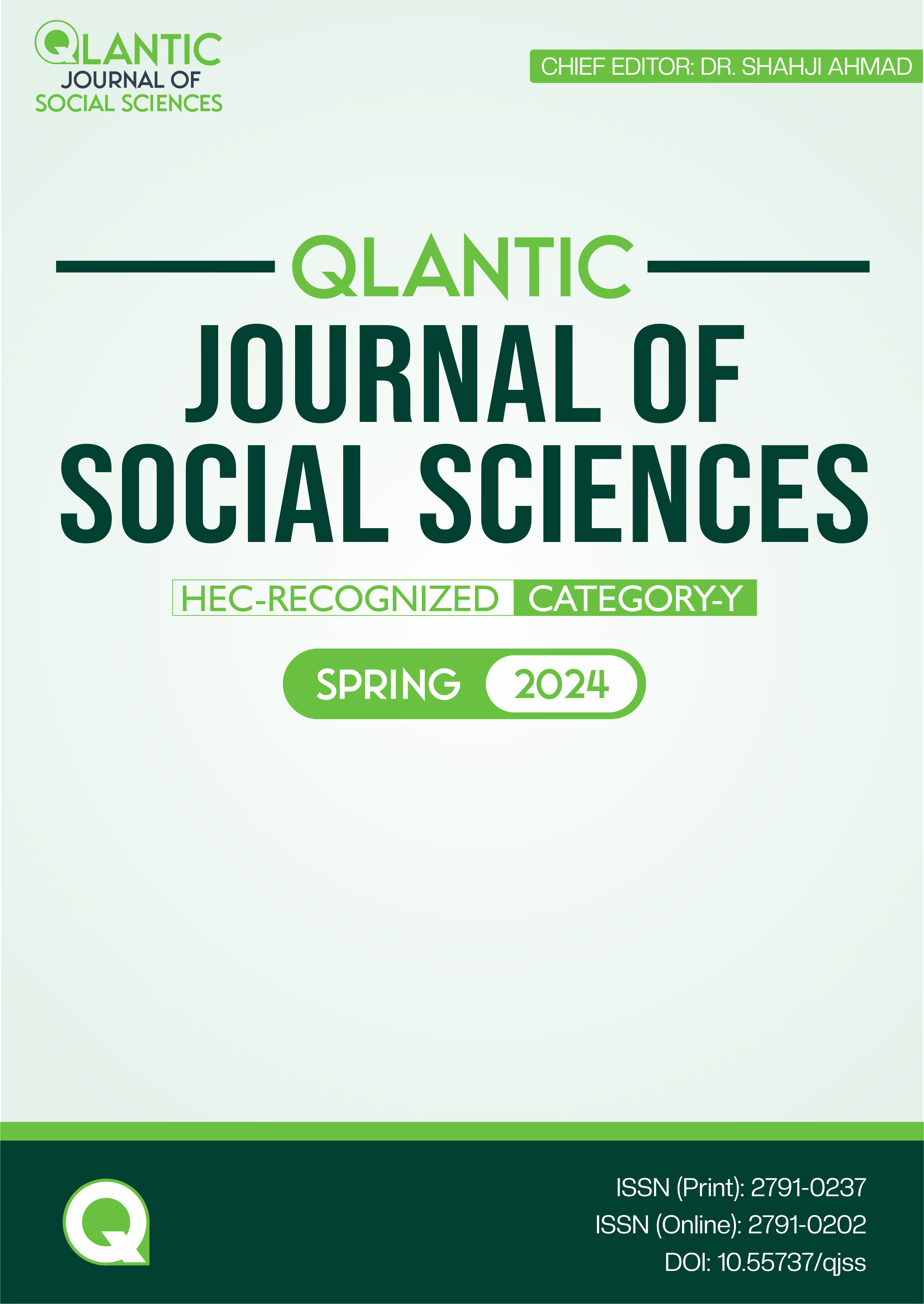Islamic Leadership Style and its Relation to the Academic Leaders’ Work Performance in Southern Universities of Khyber Pakhtunkhwa
DOI:
https://doi.org/10.55737/qjss.573131386Keywords:
Islamic, Leadership Style, Correlation, Academic Leaders, Teaching Faculty, Works PerformanceAbstract
This descriptive study was conducted with the aims to investigate the academic leaders’ practice of Islamic leadership style in southern universities of Khyber Pakhtunkhwa, to find out the level of work performance of the academic leaders perceived by their teaching faculty, and to find out the correlation between academic leaders’ Islamic leadership style with their work performance. Data were collected from teaching faculty working in different departments of four universities located in southern Pakhtunkhwa. Mean, SD, and Pearson Coefficient Correlation were applied as statistical tests for data analysis. The study’s results showed that academic leaders of different departments in southern universities of Khyber Pakhtunkhwa, sometimes use Islamic leadership style, and their work performance is average, as perceived by their teaching faculty, Islamic Leadership style has strong correlation with academic leader’ work performance. Researchers recommended that academic leaders should practice Islamic leadership style as it ensures the exemplary performance of the leaders and organization as well.
Downloads
References
Alsweedan, T. & Bashraheel, F. O. (2004). Making the leader. Saudi Arabia, Jareer Bookstore.
Amanchukwu, Rose Ngozi, Gloria Jones Stanley, and Nwachukwu Prince Ololube. "A review leadership theories, principles and styles and their relevance to educational management." Management 5, no. 1 (2015): 6-14.
Basri, B., Dewi, R., & Purba, S. (2021). The influence of visionary leadership style on organizational commitment of private university lecturers. Al-Ishlah : Jurnal Pendidikan, 13(3), 1799–1805. https://doi.org/10.35445/alishlah.v13i3.730
Blanchard, K. (2007). Leading at a higher level. New Jersey: Prentice Hall
Budiharto, S., & Himam, F. (2006). Konstruk teoritis dan pengukuran kepemimpinan profetik. Jurnal Psikologi UGM, 33(2), 133–145. https://doi.org/10.22146/jpsi.7081
Bush, T. (2003). Theories of educational leadership and management (3rd edition). London: Sage Publications.
Ciulla, J. B. (2004). ‘Ethics and leadership effectiveness’, in J. Antonakis, A. T. Cianciolo, and R. J. Sternberg (eds.), The nature of leadership, pp. 302–28. Thousand Oaks, California: Sage Publications.
Coleman, M. & P. Early (2005). Leadership and management in education: cultures, change and context. Oxford: Oxford University Press.
Cooper, M. D. (2018). The Safety Culture Construct: Theory and practice. In SpringerBriefs in applied sciences and technology (pp. 47–61). https://doi.org/10.1007/978-3-319-95129-4_5
Eliza Meiyani, & Aditya Halim Perdana Kusuma Putra. (2019). The relationship between Islamic leadership on employee engagement distribution in FMCG industry: Anthropology business review. Journal of Distribution Science, 17(5), 19-28. https://doi.org/10.15722/jds.17.5.201905.19
Haq, M. a. U., & Kuchinke, K. P. (2016). Impact of leadership styles on employees’ attitude towards their leader and performance: Empirical evidence from Pakistani banks. Future Business Journal, 2(1), 54–64. https://doi.org/10.1016/j.fbj.2016.05.002
Hashim, A. J., & Hashim, M. K. (2012). Exploring the leadership styles among Takaful agency leaders. International Conference on Islamic Leadership-2 (ICIL), Kuala Lumpur, Malaysia.
Hinkin, T. R., & Schriesheim, C. A. (2008). A theoretical and empirical examination of the transactional and non-leadership dimensions of the multifactor leadership questionnaire (MLQ). The Leadership Quarterly, 19(5), 501-513. https://doi.org/10.1016/j.leaqua.2008.07.001
Isma, I., Asad, A., Dedi, P. & Muchlis, R., (2018). ‘The effect of Islamic visionary leadership, organizational behavior, persuasive communication and organizational commitment on the professionality of honorary employees’, Indonesian Journal of Educational Review 5(1), 68–77.
Kesumayani, H., Eliyana, A., Hamidah, Akbar, M., & Sebayang, K. D. A. (2020). Boosting Organizational Commitment Through Visionary Leadership and Work Life Balance. Systematic Reviews in Pharmacy, 11(9), 312–322. https://doi.org/10.31838/srp.2020.9.48
Kurniadi, R., Lian, B., & Wahidy, A. (2021). Visionary leadership and organizational culture on teacher’s performance. Journal of Social Work and Science Education, 1(3), 249–256. https://doi.org/10.52690/jswse.v1i3.112
Meiyani, E., & Kusuma, A. H. P. (2019). The Relationship Between Islamic Leadership on Employee Engagement Distribution in FMCG Industry: Anthropology Business Review. Journal of Distribution Science 17(5), 19-28. https://doi.org/10.15722/jds.17.05.201905.19
Miharja, R., & Hayati, N. (2021). The importance of visionary leadership and talent management to improve the employee performance. Holistica, 12(2), 93–101. https://doi.org/10.2478/hjbpa-2021-0016
Moidunny, K. (2009). The Effectiveness of the National Professional Qualification for Educational Leaders (NPQEL) [Unpublished Doctoral Dissertation]. Bangi: The National University of Malaysia.
Mussolino, D., & Calabrò, A. (2014). Paternalistic leadership in family firms: Types and implications for intergenerational succession. Journal of Family Business Strategy, 5(2), 197–210. https://doi.org/10.1016/j.jfbs.2013.09.003
Northouse, P. G. (2010). Leadership: theory and practice. Thousand Oaks, CA, and London: Sage Publications
Pučėtaitė, R. (2014). Stimulating organizational Innovativeness through ethical leadership practices: The mediating role of organizational trust. Procedia - Social and Behavioral Sciences, 156, 231-235. https://doi.org/10.1016/j.sbspro.2014.11.180
Shanti, C., Imam, G. & Dan Ahmad, Y., (2020). Relationship of school Islamic visionary leadership and organizational climate with teacher performance [Conference Presentation]. 1st International Conference on Information Technology and Education (ICITE 2020), pp. 624–629, Atlantis Press, s.l.
Shooshtarian, Z., & Amini, M. (2012). The Study Of Relationship Between Leaders’ Behavior And Efficiency And Return On Investment. Polish Journal of Management Studies, 6(1), 55–67. https://ideas.repec.org/a/pcz/journl/v6y2012i1p55-67.html
Syarif, S. & Lina, H., (2019). ‘Islamic visionary leadership and the self efficacy with organizational commitment’, Jurnal Kepemimpinan Pendidikan 2(2), 308–327. https://doi.org/10.22236/jkpuhamka.v2i2.4868.
Xie, Y., Xue, W., Li, L., Wang, A., Chen, Y., Zheng, Q., … Li, X. (2018). Leadership style and innovation atmosphere in enterprises: An empirical study. Technological Forecasting and Social Change, 135(C), 257–265. https://doi.org/10.1016/j.techfore.2018.0
Yates, N., Murat, T., Jeanine, P., Daan Van, K. & Patrick, J.F., (2018). The Dark Side of Visionary Leadership in Strategy Implementation: Strategic Alignment, Strategic Consensus, and Commitment. Journal of Management, 46(5), 637–665. https://doi.org/10.1177/0149206318811567
Published
Issue
Section
License
Copyright (c) 2024 Gulap Shazada, Naseer Ud Din

This work is licensed under a Creative Commons Attribution-NonCommercial 4.0 International License.




